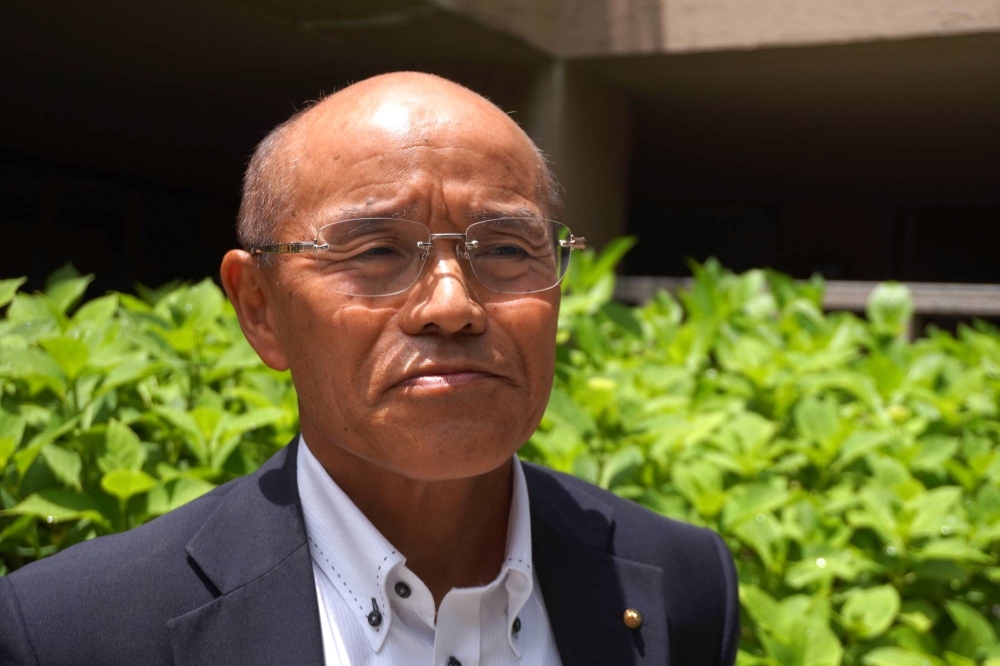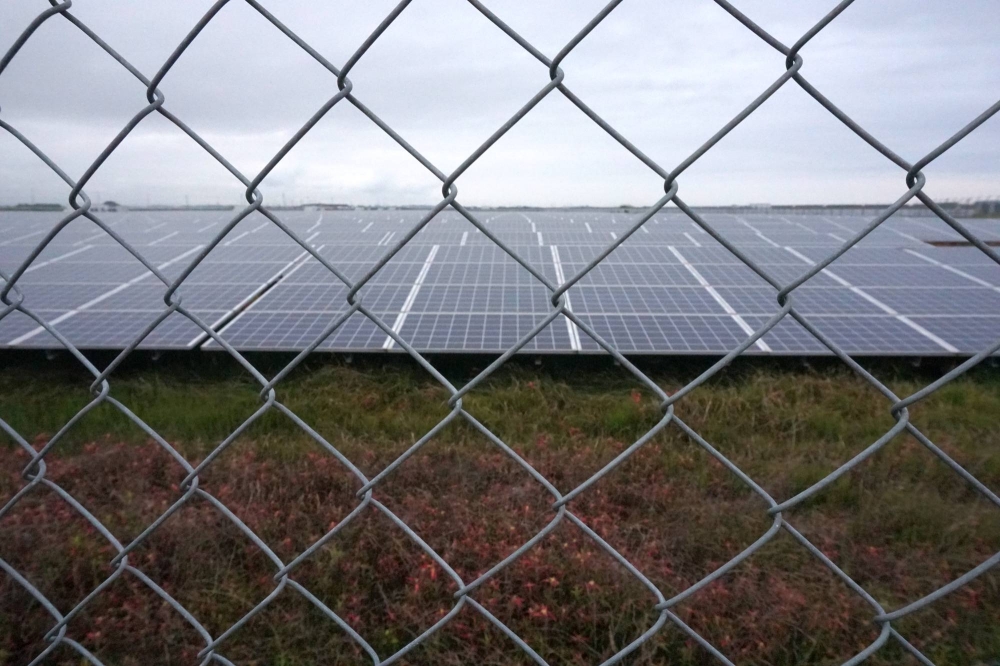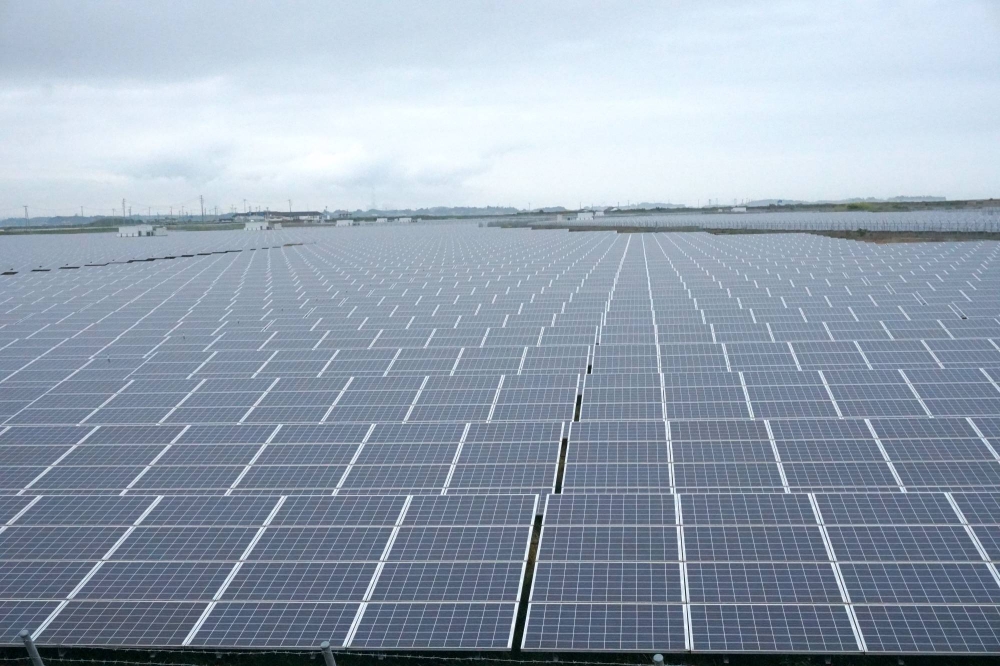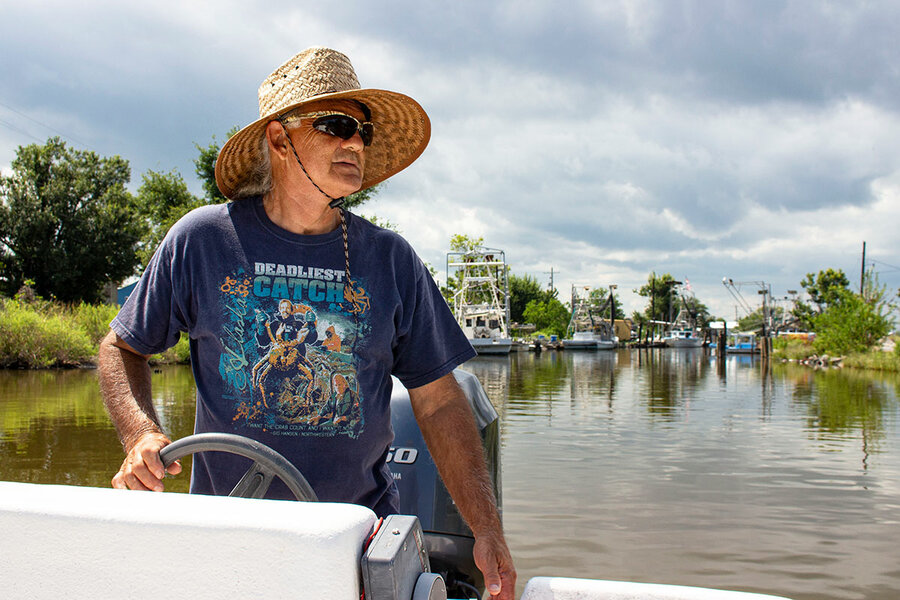Original publication by Franceso Bassetti for japantimes.co.jp on 5 September 2023

FRANCESCO BASSETTI
MINAMISOMA, FUKUSHIMA PREF. – As you reach the coast on Fukushima Prefectural Route 74, which runs between the towns of Minamisoma and Soma, scenes typical of the Japanese countryside — rice paddies and hills blanketed by lush green forests — undergo a swift transformation.
Now, expanses of metal, glass and silicon shimmer in the midday sun, stretching out to a horizon dotted with four white wind turbines, blades humming as they turn in the summer breeze.
Following the 2011 triple disaster — and the subsequent cratering of support for nuclear energy — Fukushima Prefecture has positioned itself at the forefront of Japan’s low-carbon transition.
Few projects better exemplify that than the Minamisoma Mano-Migita-Ebi solar power plant, which was the largest in Fukushima Prefecture until 2019 and is made up of 220,000 solar panels that, if laid end to end, would cover 350 kilometers — roughly the distance between Nagoya and Tokyo. The panels can generate up to 60 megawatts of electricity, enough to power 20,000 households.
Because of projects like the Minamisoma facility, Fukushima Prefecture has claimed the crown as the Tohoku region’s leader in cumulative solar power generation since 2013, and this is a direct consequence of the reconstruction policies that were put in place after the March 2011 earthquake, tsunami and nuclear disaster.
But today, grid connection issues, opposition by incumbent energy companies and a return to nuclear energy in some parts of the country are slowing progress in Fukushima and beyond. In 2022 almost 80% of the increase in total electricity generation in Japan came via fossil fuels — a worrying signal that, although renewable energy generation continues to increase, it is not keeping up with the pace of electrification.
Renewable recovery
Particularly in the coastal areas of Fukushima Prefecture, solar panels have a strong presence: They cover fields, occupy clearings that have been carved out of forests and hillsides, and rest on the rooftops of houses. Cars and trucks brandishing the names of the companies that operate them are a regular feature as they carry equipment and workers along well-kept roads.
“Immediately after the disaster, we decided to promote renewable energy as a central part of our reconstruction efforts,” says Katsunobu Sakurai, who was mayor of Minamisoma when the earthquake hit, a post he held until 2018. His administration was responsible for implementing the Minamisoma Renewable Energy Promotion Vision, which set the ambitious goal of meeting 100% of the town’s energy needs with renewables by 2030.

FRANCESCO BASSETTI
Yet, Sakurai’s vision went beyond the promotion of renewables as an alternative to nuclear energy.
“With traditional power plants such as nuclear or thermal ones, the premise is that power companies produce electricity and people just consume it,” he says. “I wanted to change this premise, so that people would become responsible for their own energy production and consumption.”
Residential solar panel installation became a hallmark of Sakurai’s reconstruction policy, which had to contend with a devastated coastline — approximately 3,000 homes in the city were either damaged or washed away entirely by the tsunami — and a crippled energy system.
Large corporations and renewable energy companies have also been quick to join the effort.
“Following the destruction of 2011, we were eager to work with local companies to build a wind farm that would stand out as a symbol of reconstruction and an alternative to nuclear power generation,” says Chiharu Sato, business manager at Hitachi Power Solutions, the company that built the Manyo no Sato wind farm, whose four turbines rise adjacent to the Mano-Migita-Ebi solar power plant. The Manyo no Sato wind farm is owned and operated by HSE, which is a subsidiary of Mitsubishi HC Capital.
“In 2022 we satisfied approximately 96% of electricity demand in Minamisoma with renewables, of which 97% was provided by solar power and 3% by wind,” says Hironobu Hashimoto, head of carbon neutrality promotion with Minamisoma’s Environmental Policy Section.

FRANCESCO BASSETTI
The prefectural government was also quick to back renewables as part of its 2011 Prefecture Reconstruction Vision policy, and in 2012 it revised its Renewable Energy Promotion Vision with a new pledge to meet 100% of Fukushima Prefecture’s energy demand with renewables by 2040, with a mid-term target of 70% by 2030.
“Recovery plans have always been tied to developing a society that is no longer dependent on nuclear power,” says Masaki Moroi, deputy director of Fukushima Prefecture’s Energy Division.
By the end of 2021, Fukushima Prefecture had covered 47% of its energy demand with renewables, compared with just 23.7% in 2011. That’s a particularly impressive feat when compared with Japan’s national average of just 22.7% in 2022.
“Fukushima took the lead after 2011 because of its direct experience with disaster and clear commitment by policymakers to quit nuclear energy and back renewables,” says Hikaru Hiranuma of the Tokyo Foundation for Policy Research.
According to Hiranuma, the single most influential policy in the initial boom in renewable energy was the introduction of a feed-in-tariff program by the Ministry of Economy, Trade and Industry in July 2012.
Feed-in-tariff programs oblige utilities to purchase electricity generated by certified renewable sources at fixed prices for a set period of time.
“The high prices set in 2012, particularly for solar energy, led to a surge in investment as new providers were promised a stable environment in which to work,” says Mika Ohbayashi, director at the Renewable Energy Institute, an independent think tank that has been working to promote climate neutrality and renewable energy in Japan since 2011.
The average annual growth rate of renewable energy — of which the lion’s share came in the form of solar — went from 9% between 2009 and 2012, to 26% between 2012 and 2016.
“This shows how important policy is for renewable energy development and the need for clear roadmaps by the government,” Hiranuma says.
Community acceptance
As renewable energy development continues to grow, so have instances of local opposition around the world.
Objections vary from concerns over land use change — and the potential consequences that this can bring if rigorous environmental assessment standards are not met — to the so-called NIMBY views of residents who reject various forms of new infrastructure in their neighborhoods.

FRANCESCO BASSETTI
However, in the aftermath of the 2011 disaster, this wasn’t a major issue for Fukushima Prefecture.
“Minamisoma designated tsunami-affected agricultural land and abandoned mountainous areas affected by the nuclear accident as renewable energy zones where large-scale solar power and wind power facilities could be established,” Hashimoto notes.
Beyond Minamisoma, Fukushima Prefecture implemented policies promoting renewable energy projects in areas affected by the tsunami and nuclear fallout where there were high rates of abandoned land.
In Okuma, one of the two municipalities that is home to the crippled Fukushima No. 1 nuclear plant, the entire population of about 11,500 people was evacuated in March 2011. Since the evacuation order was partially lifted in 2022, there have been significant investments in making the town a business and renewable energy hub. However, the return rate of the population was only around 2% as of June 2022, and large areas are still fenced off from the outside world as rich green vegetation sprouts up through cement driveways and takes over abandoned houses.
Yet local policymakers hope to make more land available for renewable energy projects as the central government continues with decontamination plans.
“Due to various regulations, only decontaminated land can be used for renewable energy projects,” says Yosuke Saito, chief of the town’s Zero Carbon Promotion section. Saito expressed hope that full decontamination will happen as soon as possible.
However, not all agree with this approach toward renewables.
“The end goal was always to revitalize the areas that we lost after the nuclear accident, and covering disused farmland and forests with solar panels amounts to giving up,” Sakurai says.
In the neighboring village of Iitate, the Iitate Electric Power Company has been experimenting with solutions to this issue through solar-sharing projects, which combine agricultural production and renewable energy generation by installing 3 meter-high solar panels that allow for uncompromised crop production below. Dozens of farmers in the area have implemented these systems and solar panels can be seen rising above vibrant fields.
“Regardless of size, renewable energy projects have to be carried out with the understanding of local communities,” says Moroi, who insists that Fukushima Prefecture works closely with the national government and municipalities to ensure environmental impact assessment procedures are respected and that projects are carefully explained to local communities.

FRANCESCO BASSETTI
A 2021 survey conducted by the prefecture revealed that 54.5% of respondents expressed an interest in or stated that they were already using renewable energy in their daily lives. “Social acceptance is essential and if it can be reached and the proper environmental assessments are done, then mega solar projects are not necessarily a problem,” Hiranuma says.
Furthermore, Fukushima Prefecture’s efforts to bring renewables into the lives of its residents have not been limited to developing renewable power plants.
“We have created job opportunities, fostered research and development on renewables, worked toward building smart communities, and promoted the use of renewable energy in public facilities,” says Kazuhide Hamao, assistant director of Fukushima Prefecture’s Next Generation Industry Division.
One of the prefecture’s flagship projects is the development of a “hydrogen society,” which experts at the Fukushima Hydrogen Energy Research Field in Namie — home to one of the world’s largest hydrogen production units — believe can provide a valuable solution to problems related to renewable energy storage and intermittency.
Headwinds remain
From Geiger counters set up at town entrances — reassuring passersby that radiation levels are safe — to thermal power plants burning fossil fuels alongside renewable energy projects that increasingly take up disused land, Fukushima’s coastline acts as a window into the struggles of Japan’s energy future.
“Although renewable expansion has been going well in Fukushima, the 2040 target remains ambitious,” says Hiranuma, who believes that key issues include a need to improve grid infrastructure and the absence of clear and coordinated decarbonization and energy policies at the national level.
“Fukushima has huge open capacity on the electricity grid due to the decommissioning of its nuclear power plants, yet the local grid system is quite weak,” says Ohbayashi.
Poor electric grid infrastructure in areas with strong and consistent wind — like Hokkaido and the Tohoku region that Fukushima is a part of — will play a major role in holding back large-scale development of offshore wind power, which the Japanese government sees as the renewable energy source with the most potential.

FRANCESCO BASSETTI
Furthermore, Japan’s grid system has comparatively weak interregional coordination, which hinders surplus energy transmission.
“Enhancing the transmission system and connecting separate regions is the most important infrastructure issue that needs to be solved so that excess energy can be distributed according to where it is needed,” says Hiranuma.
However, incumbent utilities are not always willing to play ball.
“Before the (feed-in-tariff) induced solar boom, incumbent utilities would make the bulk of their profits by selling energy during peak times, when the cost of energy was at its highest,” says Ohbayashi. “However, with high levels of renewable energy penetration, peak demand can be covered with solar or other renewables, therefore eating into profits.”
Whereas up to 2010 incumbent utilities operated on the assumption that solar would simply help cover peak loads, its proliferation has forced them to reassess the role of renewables in the energy system.
“They underestimated the power of renewables to expand,” Ohbayashi says.
Yet, incumbent utilities are by no means defenseless. According to the Renewable Energy Institute, part of the feed-in-tariff program includes a rule that allows grid operators to enforce curtailment of renewable energy without prior warning or compensation for up to 30 days per facility per year. “This has left many companies questioning the profitability of investing in renewable energy projects in Japan,” Ohbayashi says.

FRANCESCO BASSETTI
Barriers to entry have been particularly pronounced for new wind projects. For example, Ohbayashi says, environmental assessment procedures for wind power are stricter than coal-fired power plants, and it currently takes eight years for new wind power projects to become operational.
“’By making access to the grid more difficult, the expansion of wind power has also been blocked,” says Ohbayashi.
Japan is also transitioning from the feed-in-tariff program to a feed-in-premium one, which has increased competition for new operators, making it more difficult for renewable energy developers to see guaranteed returns on their investments.
“In order to accelerate corporate investment in renewable energy, the central government needs to show a clear commitment to making renewable energy the mainstay,” says Hiranuma, who also sees the government’s rekindling of nuclear energy as a potential hindrance to renewables.
“It sends mixed messages about what source of energy they are betting on for a low-carbon future.”




